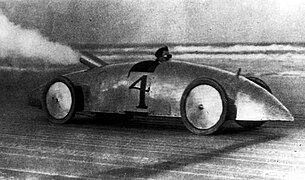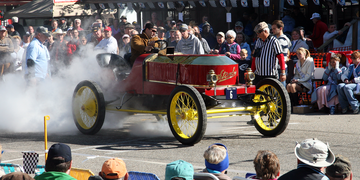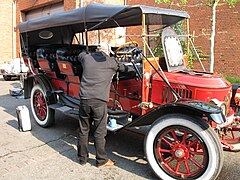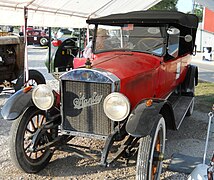Stanley Motor Carriage Company
 From Wikipedia - Reading time: 7 min
From Wikipedia - Reading time: 7 min
 | |
| Industry | Automobile |
|---|---|
| Founded | 1902 (first vehicle produced 1897) |
| Defunct | 1924 |
| Fate | Sold and dissolved |
| Headquarters | Maple Street in Watertown, MA, United States |
Key people | Francis Edgar Stanley and Freelan O. Stanley |
| Products | Vehicles |
The Stanley Motor Carriage Company was an American manufacturer of steam cars that operated from 1902 to 1924, going defunct after it failed to adapt to competition from rapidly improving Internal combustion engine vehicles. The cars made by the company were colloquially called Stanley Steamers although several different models were produced.
Early history
[edit]
Twins Francis E. Stanley (1849–1918) and Freelan O. Stanley (1849–1940) founded the company, after selling their photographic dry plate business to Eastman Kodak. They made their first car in 1897. During 1898 and 1899, they produced and sold over 200 cars, more than any other U.S. maker.[1]
In 1899, Freelan and his wife Flora drove one of their cars to the top of Mount Washington in New Hampshire,[2] the highest peak in the northeastern United States. The ascent took more than two hours and was notable as being the first time a car had climbed the 7.6 miles (12.2 km) long Mount Washington Carriage Road.[2] The Stanleys later sold the rights to this early design to Locomobile. In 1902 they formed their own Stanley Motor Carriage Company.
Specifications and design
[edit]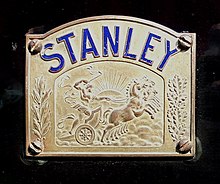


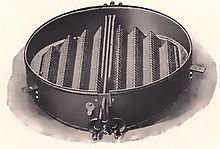

Early Stanley cars had light wooden bodies mounted on wooden "perch poles" with full-elliptic springs. Steam was generated in a vertical fire-tube boiler, mounted beneath the seat, with a vaporizing gasoline (later, kerosene) burner underneath. The boiler was reinforced by several layers of piano wire wound around it, which gave it a strong but relatively light-weight shell. In early models, the vertical fire-tubes were made of copper, and were expanded into holes in the upper and lower crown sheets.[3] In later models, the installation of a condenser caused oil-fouling in the expansion joints, and welded steel fire-tubes had to be used. The boilers were reasonably safe since they were fitted with safety valves. Even if these failed, any dangerous over pressure would rupture one of the joints long before the boiler shell itself could burst. The resulting leakage would relieve the boiler pressure and douse the burner with very little risk to the passenger. There is not a single documented incident of a Stanley boiler exploding.[4][5]
The engine had two double-acting cylinders, side-by-side and equipped with slide-valves, and it was a simple-expansion type. Drive was transmitted directly by the crankshaft to a rear-mounted differential using a chain. Owners often modified their Locomobiles by adding third-party accessories, including improved lubricators, condensers, and devices which eased the laborious starting procedure.
To overcome patent difficulties with the design they had sold to Locomobile, the Stanley brothers developed a new model with twin-cylinder engines geared directly to the rear axle. Later models had aluminium coachwork that resembled the internal combustion cars of the time, but they retained steam-car features by having no transmission, clutch, or driveshaft. They also had a fully sprung tubular steel frame.
When they later moved the steam boiler to the front of the vehicle, the owners dubbed it the "coffin nose." The compact engine ran at considerable steam pressure, with the 10-horsepower (7.5 kW) boiler described in 1912[6] as having the safety valve set at 650 pounds per square inch (4.5 MPa), with the burner set to automatically cut back when pressure reached 500 pounds per square inch (3.4 MPa). The twin-cylinder steam engines were at that time 10 horsepower, with 3+1⁄4-inch (83 mm) bore and 4+1⁄4-inch (108 mm) stroke, and 20 horsepower (15 kW) with 4-inch (102 mm) bore and 5-inch (127 mm) stroke, and made extensive use of ball bearings. In order to improve range, condensers were added from 1915.
A Stanley Steamer set the world record for the fastest mile in an automobile (28.2 seconds) in 1906. This record (127 mph or 204 km/h) was not broken by any automobile until 1911, although Glen Curtiss beat the record in 1907 with a V-8-powered motorcycle at 136 mph (219 km/h). The record for steam-powered automobiles was not broken until 2009.[7][8]
Production rose to 500 cars in 1917.
The Stanley Steamer was sometimes nicknamed "The Flying Teapot".[9] At least one Stanley Steamer found its way to Castle Hill, New South Wales, Australia where it was driven in the late 1920s.[10]
Obsolescence
[edit]During the mid to late 1910s, the fuel efficiency and power delivery of internal combustion engines improved dramatically and using an electric starter instead of the crank, which had been notorious for injuring its operators, led to the rise of the internal combustion powered automobile, which also was much cheaper. The Stanley company produced a series of advertising campaigns trying to recover the car-buying public away from the "internal explosion engine," but it was unsuccessful. Their advertising slogan was, "Power – Correctly Generated, Correctly Controlled, Correctly Applied to the Rear Axle." These were early examples of the fear, uncertainty and doubt advertising campaign, since their aim was not to convince buyers of the advantages of the Stanley Steamer but to suggest that internal combustion automobiles could explode.
Sale and closure
[edit]Francis died in 1918 when he steered his car off the road into a woodpile while attempting to avoid farm wagons travelling side by side.[11] After his death, Freelan sold his interests to Prescott Warren. The company suffered a period of decline and technological stagnation. Production specifications show[1] that no model with a power output of more than 20 hp (15 kW) was produced after 1918. Better cars were now available at much lower cost. For example, a 1924 Stanley 740D sedan cost $3,950, compared with less than $500 for a Ford Model T. The widespread use of electric starters in internal combustion cars, beginning in 1912, eroded the remaining technological advantages of the steam car.
The smaller scale of merchandising, a lack of effective advertising, and the general desire of motorists for higher speeds and faster starting than offered by Stanley vehicles were the primary causes of the company's demise. The factory closed permanently in 1924.
In popular culture
[edit]In the 1935 MGM film Ah, Wilderness!, Lionel Barrymore owns a Stanley Steamer. His character claims to have paid $5 for it. A song titled "The Stanley Steamer" appears in the 1948 film Summer Holiday (itself a remake of the above Ah, Wilderness) starring Mickey Rooney and Gloria DeHaven. The number, written by Harry Warren with lyrics by Ralph Blane, features an extended musical sequence with what appears to be a fairly early yellow 10 HP model. Stanley from Cars, Cars 2, and the Cars Toons short "Time Travel Mater" is a Stanley Steamer. Another Stanley Steamer appears in the 1965 film The Great Race starring Jack Lemmon and Tony Curtis, with Natalie Wood as the driver of the car. And a Stanley Steamer appears in the 2003 film Seabiscuit.
Boston Red Sox pitcher Bob Stanley was nicknamed "Stanley Steamer".[12]
Gallery
[edit]-
1900–06 Stanley Steamer
-
A Stanley Steamer in 1903 setting a record mile at the Daytona Beach and Road Course
-
Stanley Gentleman's Speedy Runabout, 1906
-
A 1908 Stanley leaving the starting line at the Newport Antique Auto Hill Climb
-
Stanley 30 HP 12-passenger Mountain Wagon (1912–1914) in Germany
-
Stanley Model 735B ca. 1921
-
1925 Stanley Steamer on display at the Pioneer Auto Museum, Murdo, South Dakota
See also
[edit]References
[edit]- ^ G.N. Georgano Cars: Early and Vintage, 1886–1930. (London: Grange-Universal, 1985).
- ^ a b CHRISTOPHER JENSEN (June 17, 2011). "Taming a Mountain Road With Horses and Cars". The New York Times. Retrieved September 29, 2011.
That was the day that F. O. Stanley and his wife, Flora, decided it would be good publicity for their steam-powered Stanley Locomobile if it were the first car to be driven up the 7.6-mile Mount Washington Carriage Road.
- ^ Schematic of stanley steamer
- ^ Stanley FAQ
- ^ stanleymotorcarriage.com: Boiler Introduction
- ^ Stanley Steam Cars, The Automotor Journal, Nov 30th, 1912, p1444
- ^ Glaskin, Max, Steam-powered car breaks century-old speed record, August 25, 2009, retrieved August 26, 2009
- ^ British Steam Car Challenge
- ^ "Stanley Steamer – General Information". www.stanleymotorcarriage.com. Retrieved April 3, 2010.
- ^ 'Stanley Steamer' tourer steam driven motor car, 1920s, National Museum of Australia
- ^ Doris A. Isaacson, ed. (1970). Maine: A Guide Down East. Courier-Gazette, Inc. p. 386.
{{cite book}}: Unknown parameter|agency=ignored (help) - ^
- Career statistics from Baseball Reference
External links
[edit]- Stanley Steamer – Technical Information
- Stanley Steamers in the Marshall Steam Museum
- Stanley Register Online – Worldwide register of existing Stanley steam cars
 KSF
KSF
